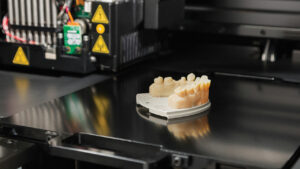Digital Workflow for Implant Prostheses

Innovation in digital dental technology is growing exponentially, and its clinical applications in implant dentistry translate into what is called a “digital workflow.” The current applications of digital dental technology in full-arch fixed implant rehabilitation of the edentulous patient include three main components: three-dimensional (3D) imaging and digital implant planning, template-guided implant surgery, and digital intraoral impressions for computer-aided design and computer-aided manufacturing (CAD/CAM) prosthetics.1–11 Together, they serve as an alternative to the traditional analog workflow for full-arch implant rehabilitation.
Radiographic examination is an essential part of the implant treatment planning phase. Cone-beam computed tomography (CBCT) allows for 3D visualization of bone and nearby anatomical structures, as well as bone quality and quantity. After the CBCT, the resultant digital imaging and communication in medicine (DICOM) files from the CBCT examination are loaded into digital implant planning software for treatment planning.
The digital planning software helps to evaluate potential sites for implant placement. Anatomical limitations, such as nerve proximity or sinus floor pneumatization and alveolar ridge deficiencies are identified, and the need for guided bone augmentation is assessed pre-operatively. Computer software enables an accurate measurement of ridge dimensions to digital implant placement and multi-unit abutment selection prior to guided implant placement. After the prosthetically driven implant placement is planned, it is transferred to the surgical field with a printed surgical template.
Computer-guided implant placement includes a combination of CBCT images, implant planning software, and a CAD/CAM-generated surgical template. Guided surgery is predictable with prosthetically driven implant positioning, reduced healing time, fewer changes in crestal bone levels, and minimal postoperative discomfort and swelling. Implant survival rate after guided surgery is comparable to conventional surgery.3
While digital planning and computer-guided implant surgery have become well-established, full-arch digital impressions have only recently been studied. Especially for the edentulous jaw, intraoral scanning has gained popularity, and several studies have shown their accuracy is comparable or even superior to conventional impressions.1,2
For a complete digital workflow, intraoral scanning with the double digital scanning (DDS) technique enables the simultaneous creation of maxillomandibular records with the impression because all the diagnostic information (occlusal vertical dimension, buccal corridors, occlusal plane, esthetics, midline, and axial tooth inclination) is embedded in the existing interim prosthesis. This decreases treatment time, making the maxillomandibular interocclusal records unnecessary. This technique takes the impression directly to prosthesis prototype try-in. Hence, the traditional five-appointment (impression, maxillomandibular interocclusal records, verification/teeth try-in, prototype prosthesis try-in, definitive prosthesis insertion) prosthodontic protocol that has long been used for definitive implant rehabilitation has been reduced to three appointments.5
The DDS technique reduces chairside time and costs while optimizing clinical prosthodontic procedures through the use of a digital workflow. Furthermore, even if a misfit of the polymethyl methacrylate prosthesis prototype is detected, the prototype can be sectioned and re-connected intraorally, and the adjusted prototype can be re-scanned and copy-milled into the definitive zirconia prosthesis. This technique can also be used at the implant placement and immediate loading appointments to further reduce the number of restorative visits from five to two, simplifying the prosthetic process.
References
- Papaspyridakos P, Vazouras K, Chen YW, et al. Digital vs conventional implant impressions: A systematic review and meta-analysisJ J Prosthodont. 2020;29:660–678.
- Chochlidakis K, Papaspyridakos P, Tsigarida A, et al. Digital versus conventional full-arch implant impressions: A prospective study on 16 edentulous maxillae. J Prosthodont. 2020;29:281–286.
- Tahmaseb A, Wu V, Wismeijer D, et al: The accuracy of static computer-aided implant surgery: a systematic review and meta-analysis. Clin Oral Implants Res. 2018;29(Suppl 16):416–435.
- Lopes A, Maló P, de Araújo Nobre M, et al. The NobelGuide® All-on-4® treatment concept for rehabilitation of edentulous jaws: a retrospective report on the 7-years clinical and 5-years radiographic outcomes. Clin Implant Dent Relat Res. 2017;19:233–244.
- Ben Yehuda D, Weber HP, Finkelman M, et al. Accuracy of guided implant surgery in 25 edentulous arches: a laboratory observational study. J Prosthodont. 2020;29:718–724.
- Amin S, Weber HP, Finkelman M, et al. Digital versus conventional full-arch implant impressions: a comparative study. Clin Oral Implants Res. 2017;28:1360–1367.
- Papaspyridakos P, Chochlidakis K, Kang K, et al. Digital workflow for implant rehabilitation with double full-arch monolithic zirconia prostheses. J Prosthodont. 2020;29:460–465.
- Rojas Vizcaya F. Retrospective 2- to 7-year follow-up study of 20 double full-arch implant-supported monolithic zirconia fixed prostheses: measurements and recommendations for optimal design. J Prosthodont. 2018;27:501–508.
- Caramês J, Marques D, Malta Barbosa J, et al. Full-arch implant-supported rehabilitations: A prospective study comparing porcelain veneered zirconia frameworks to monolithic zirconia. Clin Oral Implants Res. 2019;30:68–78.
- Tischler M, Patch C, Bidra AS. Rehabilitation of edentulous jaws with zirconia complete-arch fixed implant-supported prostheses: An up to 4-year retrospective clinical study. J Prosthet Dent 2018;120:204-209
- Papaspyridakos P, Chen YW, Gonzalez-Gusmao I, et al. Complete digital workflow in prosthesis prototype fabrication for complete-arch implant rehabilitation: a technique. J Prosthet Dent. 2019;122:189–192.
From Decisions in Dentistry. January/February 2024; 10(1):46


